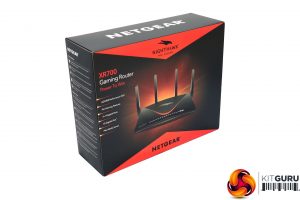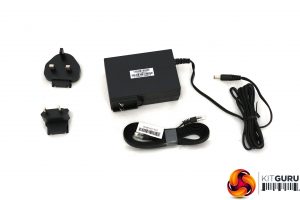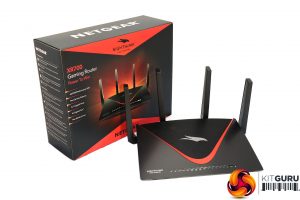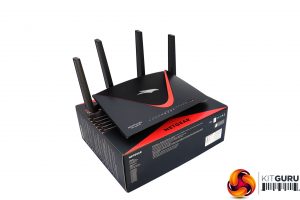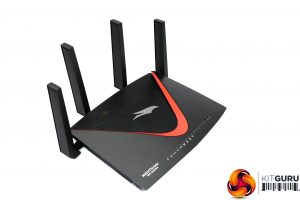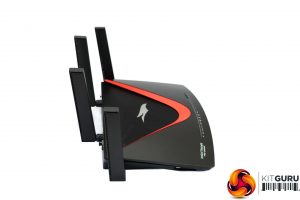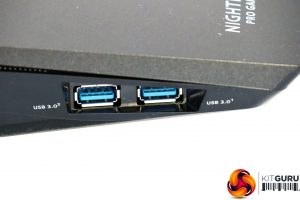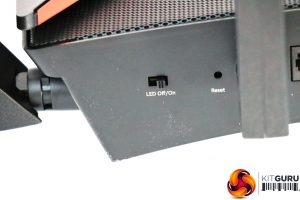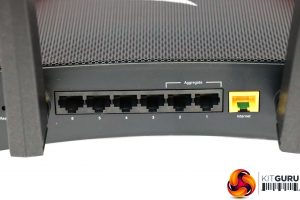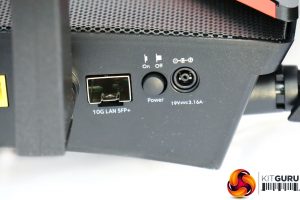Since the NETGEAR Nighthawk XR700 is part of the company's Pro Gaming selection, the box design follows this range's more colourful motifs. You get the usual external power supply with UK and European plug options inside, plus a solitary Cat 5 Ethernet cable.
You certainly get a lot of router for your lots of money with the XR700. This is a big bit of kit.
The design hasn't changed hugely from the R9000, but the XR700 replaces the X-shaped motif with a V of red and the Nighthawk Pro Gaming logo.
The R9000 looked like a serious device, but these changes give the XR700 an appropriate dash of colour to provide a little more excitement, without detracting from the overall sense of a quality product. The huge antennas are permanently attached, and bode well for a solid, long-range signal.
There's a lengthy array of status LEDs along the front, providing information about the myriad different WiFi and wired connections available. Next to the LEDs are buttons for WPS automatic WiFi connection and turning the WiFi radios off and on.
The two USB 3.0 ports can be found on the left-hand side of the unit, hidden beneath an overhang and recessed. This might make some USB Flash Memory devices a bit hard to plug in, and indeed our test drive was a snug fit on the front port.
It slid into the rear one more smoothly, however. You can also hook up a printer via USB to one of these ports and share it across your network.
The rear of the XR700 is veritably bristling with connectivity and features. Looking at the device from the rear, the far left sports a switch for turning the LED lighting off and on, plus a reset button inside a hole that you will need to poke with a paper clip to operate.
In the middle is the Gigabit Ethernet switch. There are six regular Gigabit ports plus an extra one that is dedicated for WAN broadband connections. The two ports next to the yellow WAN connection can be aggregated for faster throughput to another switch or NAS box. NETGEAR's own SX10 gaming switch and some of its ReadyNAS range offer port aggregation that could take advantage of this.
However, there's potentially an even better option for the SX10 on the right-hand side of the rear. This is the 10Gbit SFP+ port. Unfortunately, if you own the SX10 you won't be able to plug into this out of the box, because the SFP+ port is a multi-use connection supporting a variety of modules. These range from options supplying 8 or 16Gbits/sec FibreChannel, 10Gbit Ethernet or Optical Transfer Network OTU2.
For use with the SX10, you will need a module to convert the SFP+ to 10Gbit over copper, and a Cat 6a Ethernet cable that supports 10Gbit speeds (regular Cat 5 cables don't). Be prepared to pay £300 for a module like NETGEAR's AXM765. Although the SFP+ connection allows flexibility, we're not really sure why NETGEAR didn't just put a 10Gbit copper Ethernet port on the XR700 like the SX10, if they meant the two to work together. Not many users are going to pay another £300 for the AXM765 module. Port aggregation seems like the much more viable and cost-effective option, albeit slower.
Nevertheless, the XR700 is packed with physical features and plenty of connectivity. We loved the XR500, but its more modest hardware specification and fewer LAN ports give the XR700 greater potential as the hub of a big gaming and entertainment network.
 KitGuru KitGuru.net – Tech News | Hardware News | Hardware Reviews | IOS | Mobile | Gaming | Graphics Cards
KitGuru KitGuru.net – Tech News | Hardware News | Hardware Reviews | IOS | Mobile | Gaming | Graphics Cards


